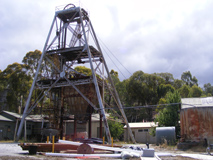
Wattle Gully Mine
A remarkably intact working mine, with poppet head, engine house and ore crushing battery.
| Access: by car to within 200m of viewing area | Period: 1850’s to the present |
| Time: Allow 20-30 mins | Stories: People, mining companies, technology |
A remarkable accident of fate led Wattle Gully to become one of the richest gold mines in Victoria.
In 1934 a shaft was sunk from the bottom of the old 1890’s shaft to intersect the gold reef, but when the right depth was reached scarcely any gold was found.


Where was the gold-rich stone?
The answer is a perfect example of the capricious nature of mining. A survey found that the drill had been deflected westwards, striking a new lode of gold. The biggest and richest quartz gold deposit in the district's history (it would yield 350,000 ounces of gold in the next 30 years) had been discovered by chance. If the drill had gone straight, gold worth around $140 million would lie there, undiscovered, today.
The long life of the Wattle Gully mine spans the history of mining technology. Wattle Gully was first worked in 1853, when gold-seekers dug away the ten metres of soil covering the gully bed. They not only won huge amounts of alluvial gold, but unearthed a quartz reef studded with the precious metal.
Verne Hooper, a miner at Wattle Gully in the mid 1900’s tells stories of humour and great hardship.
Over the many years of work at Wattle Gully, the mine claimed seven lives altogether, at different times. Countless men had broken legs, arms, eyes knocked out, and very serious cuts and abrasions. Strangely enough, most men went back for more, trying to remember what mistakes they had made, and trying not to make them again.
I have lost count of the number of times being carried out on a stretcher. My best count was twice in three days. This was when we were putting a rise through to the surface from the 200 feet level. I remember Barney Gillon, the pay clerk, bringing down a bottle of brandy to the shaft head, and giving it to my mate, Fred Smart, and myself. This was, of course, to help us recover. Two days later, we were gassed again, and he brought down another bottle of brandy. This time he said to us, "If you get gassed again, you can buy your own bloody brandy.
- Mining My Past, by Verne Hooper.
To work the reef, miners formed small cooperative parties, at first quarrying the reefs and extracting gold with hammers and chisels. When the shafts deepened, and went below the water table, large companies were formed and a technological revolution developed, Wattle Gully is arguably Australia's oldest working mine, and there are many former miners in the local community who bring its historic relics to life with their stories.
One account of just what happened to that drill in 1934.

Three diamond drill holes were bored from the 196 ft level in the directions shown to try to determine where the Phillips Reef came within their claim. Drill 1 intersected the ore body at A, in the neighbouring lease, and showed a fairly poor gold content. Another (Drill 2) was bored slightly downwards to intersect the reef at point B, in their lease. This also showed low gold content. Drill 3 was then drilled at a steeper angle to possibly intersect the reef at D. In fact the drill moved off path and travelled in a curve to intersect the reef at E. This showed very payable ore at 5 oz per ton but the engineers expected this to be at point C so the shaft was to be sunk to 650 ft and then cross cut to the ore at C. When they reached 645 ft they came upon the rich ore body and the rest is history.
If the drill had not deflected they would have intersected the reef at D and since it probably would have shown very little gold content (as the other two showed) then they would possibly not have continued with the reopening of the mine.
One of the problems with Wattle Gully is that the shaft was sunk directly over the ore body (instead of to one side) and so quite a large portion of the ore body must be left there as columns to support the roof and the shaft.
View Larger Map